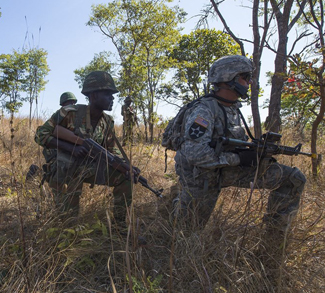While names like ISIS (or Daesh), Boko Haram, FARC, and Al-Qaeda ring familiar to many, one of the world’s deadliest groups – and potentially fastest-growing – is one most Americans are likely not familiar with.
Operating in the semi-arid Sahel region that unfolds south of the Sahara Desert, Jama’at Nusra al-Islam wa al-Muslimeen (JNIM, also known as the Group for the Support of Islam and Muslims, or GSIM) made its existence public with a March 2017 announcement merging four armed groups, many of them with links or suspected links to Al-Qaeda. Operating primarily on the fringes of Mali – where state control is limited – the group represents one of the greatest challenges to stability in Africa and potentially the wider Mediterranean.
While the group’s forerunners made their names in a variety of conflicts – including involvement in the Algerian civil war and cigarette smuggling across the Sahara – JNIM’s primary modus operandi is its attacks on UN peacekeepers, French and Malian troops, and local politicians and village elders. Led by a former international diplomat turned terrorist, Iyad Ag Ghali, the group has embraced its Al-Qaeda connections, receiving the blessing of Al-Qaeda leader Ayman Zawahiri. By exploiting ongoing instability that predates the group and ethnic grievances that extend across the Sahel, JNIM succeeded in inserting itself as a force to be reckoned with in the wider region.
The pattern of JNIM attacks also suggests a growing confidence in its abilities. The militant group initially focused its attacks on the periphery of the northern Malian frontier. Since a 2012 coup set off an ethnic Tuareg and jihadist uprising in the north, Bamako has struggled to pacify resistance to its rule there. More recently, however, JNIM has shown a willingness to move south, into central Mali, suggesting either growing confidence or internecine warfare in the north that has forced the group to flee. Regardless, attacks have continued and grown deadlier at an alarming pace. 2017 was the deadliest year on record for UN peacekeepers, with JNIM attacks in Mali playing a big part in the increase – 21 out of 71 fatalities. The group’s bombmaking expertise has also frightened some experts in the field, fueling suspicions that JNIM is sharing knowledge with a local ISIL affiliate.
In addition to operating in an already-destabilized country, Mali’s strategic location allows JNIM’s actions to echo far beyond its immediate neighbors. Like neighboring Niger, Mali is a portal joining sub-Saharan Africa to North Africa and the Mediterranean, making it a key crossing for migrants and refugees on their way to Europe. Such flows offer a potentially lucrative revenue streams to a group whose members may already be accustomed to smuggling goods across the region. Its proximity to Libya also offers the group new avenues to smuggle and purchase weapons from the conflict there. Factor in its proximity to West Africa, where many countries would struggle to handle a cross-border conflict, and it is easy to see how JNIM’s actions in Mali could easily spill across the region, necessitating greater international action. Massive refugee flows reminiscent of those seen in 2015 could repeat themselves if a sub-state actor were to spark a multi-state conflict.
While the group is not a household name in the United States, its existence has sparked action on the part of regional and EU countries. In addition to the aforementioned UN mission (MINUSMA) which has taken on protecting civilians from JNIM attacks as part of its broader mission, the European Union has launched efforts to train the Malian military, while France has launched a more direct counterterrorism mission, ongoing in its current form since 2014. Regional countries have also formed the G5 Sahel, aimed at coordinating security operations in the region and confronting shared threats, particularly JNIM.
Efforts so far have not succeeded in ousting the group, and may have even given rise to a new and worrying trend in Mali. Over three days in late June and early July, militants launched four attacks on troops and peacekeepers, killing at least 16 people. JNIM claimed responsibility for two attacks, targeting G5 forces and French troops, and the remaining attacks fit the group’s preferred methods.
Also worrying has been the response of a government that’s desperate to rein in the violence. In June 2018, three graves containing 25 bodies were found in the central Mopti region. Further investigation revealed that the deceased had been killed by members of the security forces on suspicion of belonging to JNIM and allied groups. All were members of the Fulani ethnic group, a predominately Muslim and pastoral community in the Sahel. While Mali’s defense minister quickly ordered an investigation into the killing, the incident speaks to a larger phenomenon across the region. One of JNIM’s former constituent groups – the Macina Liberation Front – championed the Fulani cause alongside its extremist ideology. JNIM has also taken up the cause, in one case engaging in a revenge attack after a Fulani teenager was killed. Echoes of this violence can be found in recent clashes in Nigeria between pastoral and agricultural communities. If left unchecked, this violence could spiral, marrying a terrorist group with substantial experience to an increasingly marginalized community that feels it has little support from the state.
Much of the violence in Mali has been limited to the Sahel – so far. Growing violence in 2012 prompted an international peacekeeping mission and continued violence in region has pushed missions to retool their focus. Neighboring countries have also responded to prevent the violence from spilling across their borders. If these efforts fail or JNIM succeeds in presenting itself as an accepted representative of members of the Fulani community, JNIM will likely become unfortunately familiar outside of Mali.
The opinions, beliefs, and viewpoints expressed by the authors are theirs alone and don’t reflect the official position of Geopoliticalmonitor.com or any other institution.




